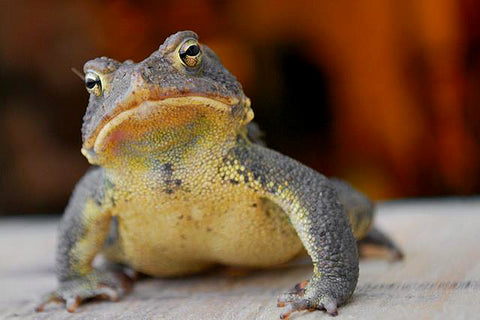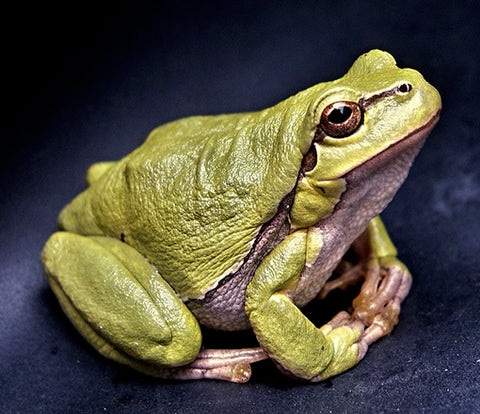
Terrestrial frogs, sometimes called toads, are land-dwelling amphibians as opposed to their aquatic counterparts. They are relatively easy to care for and can make good pets for children and adults.
With proper care, terrestrial frogs can live anywhere from 5 to 15 years! This guide covers mostly ground-dwelling frogs such as Pacman frogs and Tomato frogs.
Habitat and Housing
The most commonly used housing for terrestrial frogs is a glass aquarium or terrarium with a secure screen lid.
Most terrestrial frogs are ambush predators and lead mainly sedentary lives. This means that they usually don’t need as large of a cage as some other types of frogs (like tree frogs).
A 10-gallon aquarium (20” x 10” x 12”) or larger is suitable for a single pacman frog, or 1-2 tomato frogs. If housing more than 2 tomato frogs, you would need at least a 20-gallon long aquarium (30” x 12” x 12”).
 Pacman frogs are cannibalistic and should not be housed together. Multiple species of frogs should not be kept in the same cage, and frogs should not be housed with any other species of reptile or amphibian.
Pacman frogs are cannibalistic and should not be housed together. Multiple species of frogs should not be kept in the same cage, and frogs should not be housed with any other species of reptile or amphibian.
Substrate (Bedding)
Coconut fiber bedding is the best choice for frogs as it holds moisture well. It is also soft to the touch, with no rough edges that could damage their sensitive skin. Substrate should be about 2-3” deep and kept moist (but not dripping wet) to promote stable humidity levels.
A terrestrial frog doesn’t drink through its mouth—it absorbs water through its skin!

Cage Décor
Terrestrial frogs spend most of their time burrowed down into the substrate, waiting for insects to pass by. They can’t climb, so keep any cage décor low to the ground. They need mostly open floor space, so cage decorations should be limited to a low piece of bogwood or driftwood, and maybe a plastic plant to provide shelter.
Live plants tend not to be the best choice in a terrestrial frog’s habitat—their bodies are large and heavy enough that they can crush most varieties, and they also uproot plants when burrowing.
Make sure any driftwood or plants are arranged in a stable manner so they cannot topple and injure your pet. Also, avoid using cage decor with rough edges that could scratch their skin.
Also, it is important to avoid using any driftwood, rocks, or branches that you have found outside. They may carry pathogens that could harm your pet or may have been exposed to pesticides, herbicides, and other chemicals that could be dangerous.
Most natural materials are porous and very difficult to completely sterilize, so it's much safer for your frog if you use only professionally cleaned and sterilized items that are known to be safe.
Terrestrial frogs also need a water dish that is big enough for them to climb in and soak if needed. Water needs to be treated with a dechlorinator and kept clean at all times.
Maintenance
Remove soiled bedding and stale food daily. Spot clean several times weekly or more often as needed. The entire cage should be cleaned and sanitized at least monthly.
Clean enclosure and any décor with a 3% bleach solution, distilled vinegar and water (50/50), hydrogen peroxide, or pet-safe cleaning products.
Other Necessary Supplies
- Thermometer (preferably digital)
- Hygrometer (humidity meter)
- Spray bottle for misting
- Dechlorinator for water
- Calcium/multivitamin supplement
- Cricket cage
- Cricket food
- Pet-safe cage cleaner
- Timer for lights (optional)
Heating and Lighting
Frogs, like all amphibians and reptiles, are cold blooded (aka ectothermic) and don’t produce their own body heat. A reptile heating pad is the safest and most effective way to provide heat to your frog. Heat lamps tend to be too drying for use with most frogs.
The heat pad should be placed under the tank and should cover no more than 1/3 of the bottom of the tank to allow for a temperature gradient within the habitat.
Amphibians rely on the temperature of their surroundings to heat or cool them. It is important that a habitat include a temperature gradient, so the frog can self-regulate its body temperature.
Daytime temperatures should range from 80-85°F, at the warm end of the habitat, to 75°F at the cooler end. Nighttime temperatures can be allowed to drop to 75°F at the warm side and 70°F at the cool end, but should not drop lower than 70°F at any time.

Frogs are tropical animals, and it’s important for them to have a source of both light and heat. Most amphibians are nocturnal and don’t need UVB lighting. Although UVB is not necessary, low levels are thought to be beneficial.
To recreate natural light cycles, bulbs that emit white light should be left on 10-12 hours per day, then turned off at night. Timers can be used to turn lights on and off automatically.
Fluorescent bulbs are the best way to provide your frog with lighting. Fluorescents produce a lot of light but very little heat, so they won’t dry out your frog.
Diet
Frogs only eat live insects; they do not eat any type of plant or vegetable matter. Some of the most nutritious feeder insects include gutloaded crickets, roaches, and phoenix worms. You can also use mealworms or waxworms, but these are higher in fat and should be given more as a treat.
Most terrestrial frogs should be fed two to three times per week, as much as they can eat in 10-15 minutes. As a general guide, don’t feed your tree frog any crickets that are longer than the space between its eyes.
Be careful not to leave more than a few extra crickets running around in your frog’s habitat after it is done eating. Too many crickets climbing over the frog might stress it out, and hungry crickets might even try to take a bite out of your frog!
Frogs are healthiest and live the longest on an insect-based diet. Some people feed their large frogs mice or goldfish, which are too high in fat and protein and can cause health problems as well as a shortened lifespan.
Goldfish can also transmit parasites to your frog. Other more nutritious food options for large frogs include roaches or earthworms.
It is safest to feed your frog insects from the pet store because there’s a risk that any bugs you catch outside may have come into contact with pesticides or other chemicals that could harm your pet.
Supplementation
There are several ways to provide your terrestrial frog better nutrition through supplementation. Insects should be dusted with a powdered calcium/multivitamin just before feeding your frog. Food can be dusted at every feeding for juveniles, and once per week for adults.
Insects should also be gutloaded. This involves feeding nutritious foods to the feeder insects so your frog also benefits. You could gutload the insects with a variety of fruits and vegetables, or with a commercially made cricket food.
Hydration
Frogs should always have access to clean, dechlorinated water in a bowl that is large enough for them to soak in. They often defecate in their water, so the water bowl will need to be cleaned and refilled at least daily (possibly more often if needed).
Air humidity is also very important to frogs. In general, humidity in a frog’s habitat should stay above 50-60%, but it is also important that it not stay saturated all the time. If it is too moist, skin infections and other problems can result.
The humidity should naturally cycle from low to high throughout the course of the day. It can easily be raised by misting the frog and its habitat with room temperature, dechlorinated water from a spray bottle. Right after a misting, humidity levels can rise as high as 80-90%, then fall to 50-60% over the course of the day.
Usually misting once or twice a day is sufficient to keep the humidity at the proper levels. Special foggers for reptiles and amphibians are also available to help keep humidity high, while still allowing airflow.
Handling
Frogs have very delicate skin, and our skin is rough enough to hurt them. Any skin oils, lotions, or any other type of residues on our skin can be absorbed through their skin and make them sick. That’s why it is important to limit handling of any frog.
For times when you need to remove them from the cage (such as cleaning), you should wear rubber gloves and be especially gentle.
Signs of a healthy frog

- Active and alert
- Clear eyes
- Healthy skin
- Eats regularly and maintains weight
Red Flags
- Loss of appetite
- Weight loss
- Lethargy
- Sores, bumps, abrasions
References can be found that cover terrestrial frog health issues. There are a variety of online resources such as:
http://allaboutfrogs.org/info/doctor/sick.html
http://whitney05.hubpages.com/hub/pac-man-frog-health
Fun Facts
- Size: 2” to 10” depending on species
- Life span: 5-15 years
- Origin: South America, Africa, Asia, Australia
- Care Level: Beginner

A terrestrial frog doesn’t drink water - it absorbs it through its skin! And although a terrestrial frog has lungs, it also breathes through its skin!
Most frogs shed their skin about once a week. It is a quick process that only lasts a few minutes, so you might never see it happen. After they are done, they eat the old skin!
Pacman frogs are named after the video game character because of their round body shape and huge mouth!
Pacman frogs are big eaters, and are even capable of eating prey as large as they are! (Although it’s better to feed them several small prey items as they have trouble digesting large prey.)
In many species of terrestrial frogs, the female can grow two to three times the size of the male! One exception is the African Bullfrog or Pyxie Frog. Males of this species are much larger than the females.
Some terrestrial frogs, such as pacman frogs, have strong jaws and sometimes mistake fingers for food! If you need to pick your frog up, always scoop it up from behind instead of from the front.
This is a basic outline on caring for a terrestrial frog and is not meant to be an exhaustive guide on frog care or health. For further guidance, please refer to books, online resources, veterinarians, or animal care specialists.


